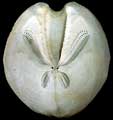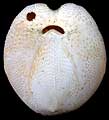The Echinoid Directory
Ova Gray, 1825, p. 431
[=Nina Gray, 1855, p. 60 (objective). ]
| Diagnostic Features |
|
|---|---|
| Distribution | Eocene to Recent, cosmopolitan. |
| Name gender | feminine |
| Type | Spatangus canaliferus Lamarck 1816; SD ICZN op. 209, 1948 [non Ova Pomel 1887, p. 701; (=Nina Gray, 1855, p. 60)]. |
| Species Included |
|
| Classification and/or Status |
|
| Remarks |
|



